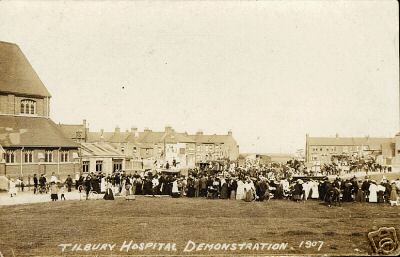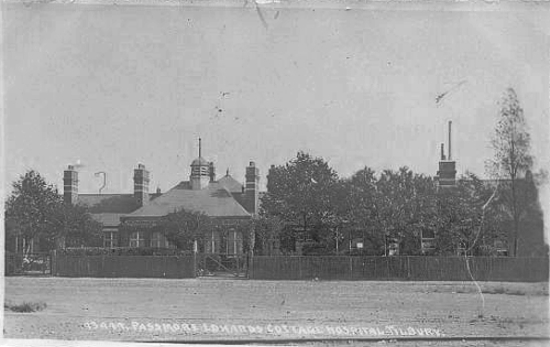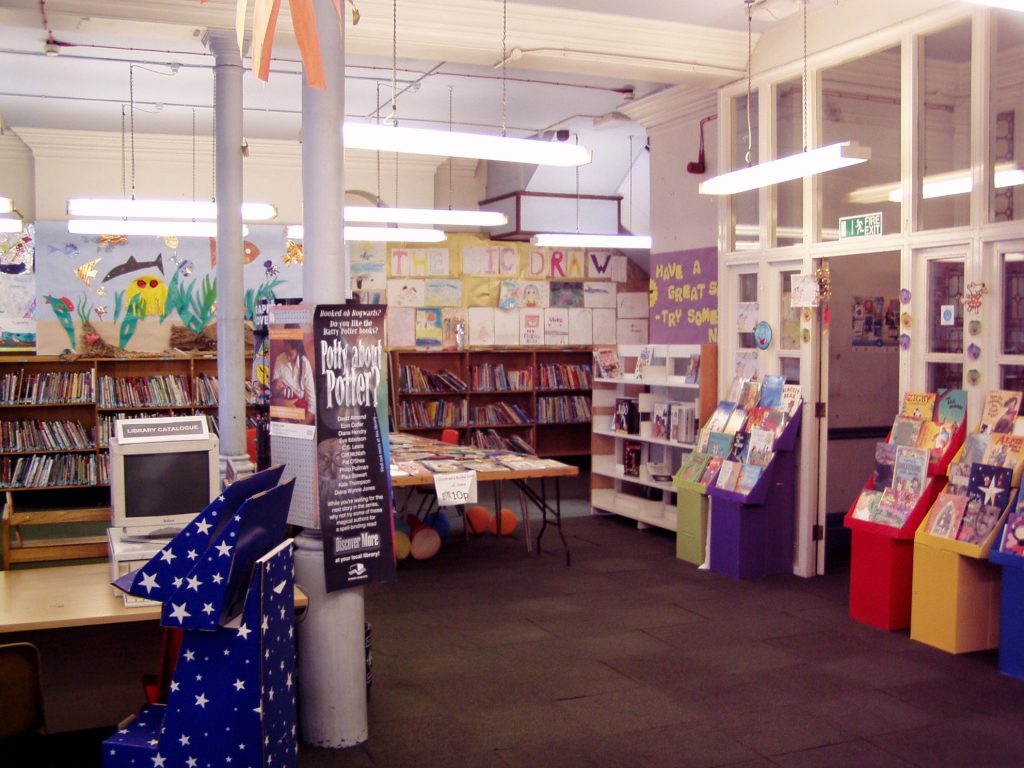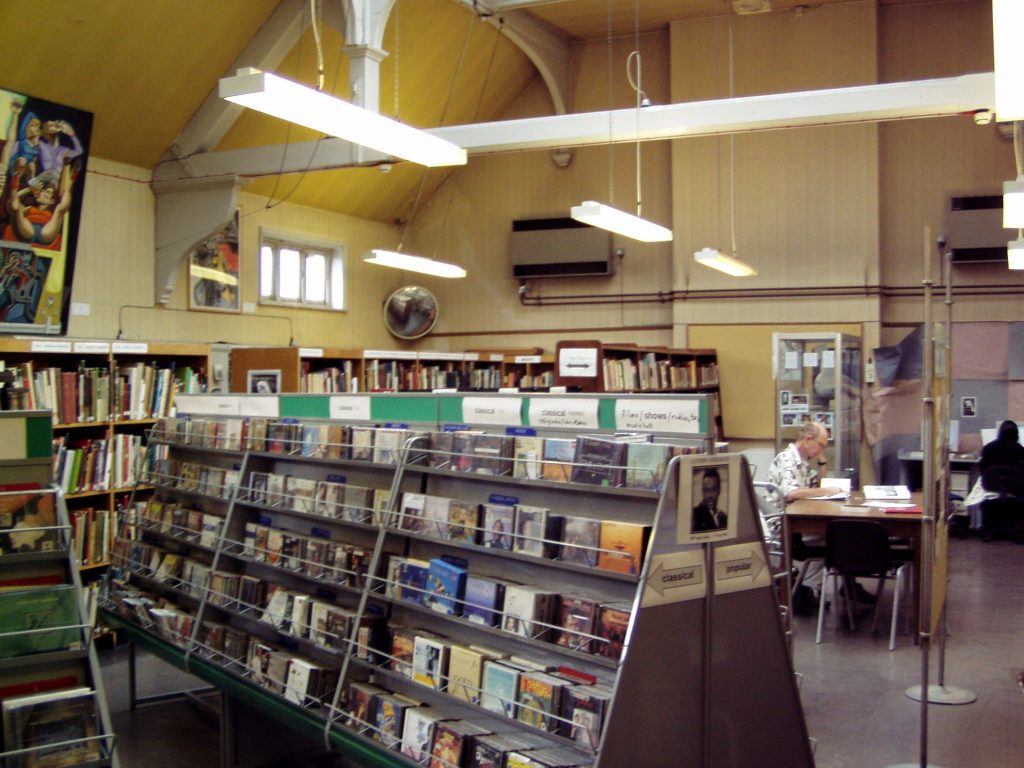Alfred Saxon Snell was the son of Henry Saxon Snell. Together with his brother Harry the three were in partnership in London under the name of H. Saxon Snell and Son. The partnership was dissolved in 1891.
Alfred was also responsible for Willesdon Workhouse and infirmary and Marylebone Public baths, later to become the Magistrates’ Court.
Author Archive: Dean Evans
Passmore Edwards’ District Cottage Hospital, Tilbury, 1896.
As far back as 1882 attempts were made by the friendly societies and others in the Tilbury District to found a Cottage Hospital without success. 12 years later a request to Passmore Edwards was responded to both promptly and positively.

Up to 1895 a man meeting with an accident at the Tilbury Docks, or anyone taken ill in that vicinity, had to be taken to Gravesend or London Hospitals. Whilst we are beginning again to see greater distances of travel to the more Regional Hospitals provided by the NHS, at the end of the 19th Century, the distance involved cost, and risk. Since 1882 efforts had been made by the friendly societies and others to establish a Cottage Hospital at Tilbury to meet the growing needs of the area but always without success. It was not until 12 years later, when a Mr Ephriam Wright wrote to Passmore Edwards to secure his help. Passmore Edwards, after some inquiries responded by offering to supply a suitable building.
The necessary Committee was formed and soon received its first subscription of £500, and an offer to provide a site, from the Tilbury Dock Company. Rowland Plumbe FRIBA was appointed as architect and the foundation stone was laid by Passmore Edwards in October 1895. The 15 bed hospital was constructed opposite the Tilbury Dock gates and was opened by Passmore Edwards in June 1896.
As the docks expanded the Hospital Committee felt that a larger hospital, with more up to date equipment, was needed to meet the demands which were being made upon it. Accordingly, in 1924, the administration of the hospital was transferred to the Seamen’s Hospital Society and it was renamed Tilbury Hospital.
Dr J J S Rowe, who had been at the Society’s Dreadnought Hospital, Greenwich, was appointed as Resident Medical Officer. It was decided to increase the accommodation to 50 inpatients and also provide proper accommodation for outpatients. Prior to the transfer the local management Committee had provided an X ray machine and refurbished the operating theatre. The aquisition of the Tilbury Hospital meant that the Society was now responsible for the care of sick and injured seamen from the whole of the Port of London.
At the same time, a Mr Singhanee, of Poona, India, had offered a gift of one lakh of rupees (£6,732 in 1924) to provide a Ward for Indian seamen at a London Hospital. The Passmore Edwards Hospital had been chosen and the “Singhanee Ward” was nearing completion when the Society took over the reins in January 1924. This was opened by the Duke of York in June 1924.
The Ladies Linen League was formed in 1924 by local ladies to provide and maintain the linen and garments of the Hospital whilst the Dreadnought Ladies League raised funds for materials used in the wards.
The Duke of York also laid the foundation stone for the new buildings which were of a “modern” concrete construction, with “metal window frames”, constructed on concrete rafts due to the poor loadbearing capabilities of the land. The roofs were of red concrete tiles. Two new wards, of 22 beds each, and a nurses home were constructed, as well as updating the hospital equipment, at a cost of about £30,000. The Hospital was later to be known, locally, as the “concrete hospital”.
The original building retained the name of the Passmore Edwards Ward.
In July 1932, “The Grays and Tilbury Gazette and South Essex Pictorial Telegraph” contained a report on the financial pressures that faced the Hospital during the depression and called for renewed local support and assistance to continue the work of the concrete hospital.
The hospital survived the depression years and continue under the management of the Society until the formation of the National Health Service, in 1948, when the hospital was taken over by the South East Essex Hospital Management Committee, serving the then Urban Districts of Billericay and Thurrock, being then the only hospital for acute surgical cases in the committee’s area. In 1950 it became Tilbury branch of Tilbury and Riverside General Hospital (combining Tilbury and Orsett Hospitals), and as such recognized as a general training school for nurses. In 1953 the Orsett Hospital was chosen in preference to the Tilbury Hospital as the main hospital for Thurrock area. Inpatient work transferred to Orsett Hospital 1969. The building was demolished in 1985.
Rowland Plumbe
Rowland Plumbe (1838-1919) studied at University College, London and was articled to Nockalls Johnson Cottingham and Frederick Peek.
After spending 2 years in America, in the office of Frederick Clark Withers, Plumbe returned to London in 1860 to commence independent practice in the City of London.
He was District Surveyor of South Islington from 1875 and of West Hamstead until 1891
Extracted from Directory of British Architects 1834-1914, British Architectural Library
Passmore Edwards Public Library, Limehouse 1900
Passmore Edwards initally offered £6000 towards the costs of the Limehouse Library but then withdrew the offer, stating “I cannot promise to substantially assist you whilst this wretched war with the Transvaal Republic is waged”. He later contributed £5000.
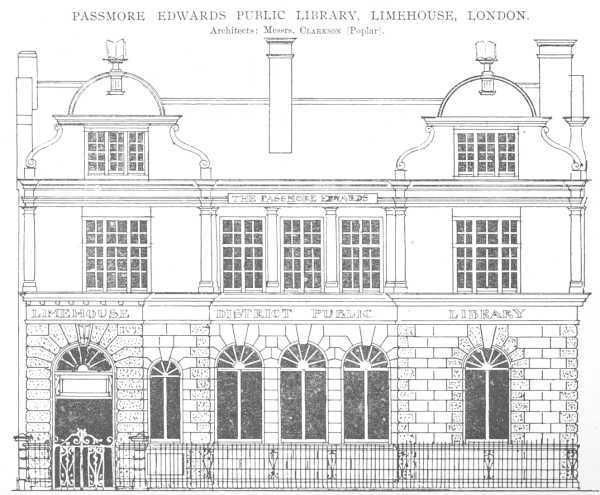
History
A poll, to adopt the Free Library Acts resulted in a 2,000 majority in favour and a board of Library Commissioners were elected to find both a site and the capital required to build it. In January 1900 the Commissioners wrote to both Passmore Edwards and Canon Barnett for assistance. Edwards initially offered to give £6,000 but within days had written to withdraw the offer, saying that he could not promise to substantially assist ‘whilst this wretched war with the Transvaal Republic is waged’. Within weeks he had changed his mind and agreed to pay £5,000 towards the building and laid the foundation stone, at 2.30pm on 19 October 1900.
Edwards declined to give a lengthy speech after laying the stone. The first reason he gave was that after leaving Limehouse he was due to lay the foundation stone of the Bow Library and at 8pm that evening he was due to unveil the memorials to Charles Keene and Leigh Hunt at the Shepherds Bush Library.
The second reason, he said, was that ‘it was difficult to make bricks without straw’- he could not make a speech without facts to speak upon. He had walked the two miles from Whitechapel to Limehouse that afternoon and said he had been struck by the absence of anything of any architectural character to relieve the monotony. But he had noticed the number of men standing about the streets with nothing to do. The library would be for these men, where they could find recreation different to lounging about.
Designed and built in Commercial Road, by Sabey & Son of Islington, the library was opened a year later by the first Mayor of Stepney, Edward Mann. Edwards was unable to attend the ceremony.
The library was originally fitted with gas lighting but, so as not to later spoil the internal decoration, the wiring for electric lighting was also installed for when it became available. In the Library’s entrance the Brockwell Collection, an exhibition of species of fish caught in the nearby River Lee between 1876-1881, was put on display.
The library closed for three years in 1928, to allow an extension at the rear to include a Children’s Library and Reading Room, both claimed to be the largest in East London, as well as a Lecture Hall with seating for 256 people. After the formation of the Borough of Tower Hamlets this lecture hall was also used for weekly feature films, with free entry.
In 1987 the Wapping Neighbourhood Committee commissioned local artist Claire Smith to design and execute a mural for the library. Painted in the style of William Blake the mural is called Limehouse Reach, a huge fresco stretching right across the rear wall of the library.
The following year a statue of Clement Attlee, MP for Limehouse from 1922 to 1950 and Prime Minister between 1945 and 1951, was erected outside the library and unveiled by Harold Wilson.
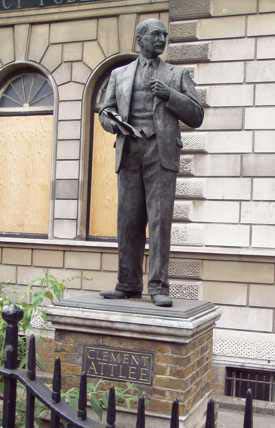

Although talk of closing the library in 1997 initially came to nothing the library’s days were numbered and it eventually closed in June 2004. The library building remained empty in a state of disrepair for many years, resulting in Historic England including the Grade II listed building to be included on the Buildings at Risk Register. Recently, however, work commenced on restoring the building to be used as student accommodation. The Attlee statue had been removed some years earlier.
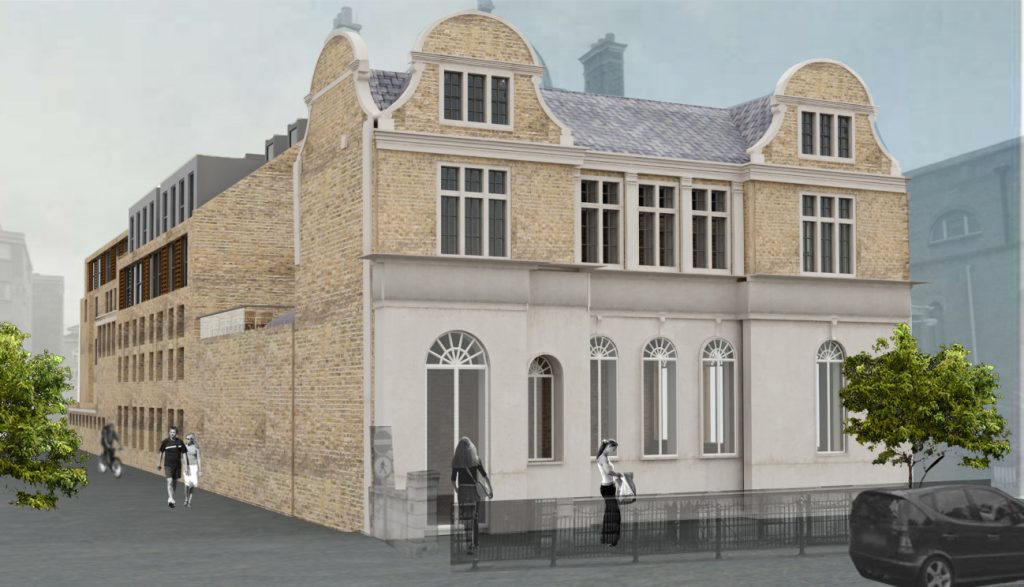
Books for all
Besides providing buildings, Passmore Edwards, from time to time, sent large contributions of books to public libraries and other institutions.
Amongst such were
Bethnell Green Free Library 1000 volumes; Barking Public Library, 1000 volumes; Bromley Public Library, 1000 volumes; Battersea Polytechnic, 1000 volumes; Borough Road Polytechnic, 2000 volumes; Cobden Club & Institute, 1000 volumes; Caxton Convalescent Home, 500 volumes; Limpsfield, Camborne Free Library, 1000 volumes; Chelsea Polytechnic, 1000 volumes; Chiswick Library & Mission Hall, 500 volumes; Cornwall Convalescent Home, 500 volumes; Technical Institute & Library, Hayle, 500 volumes; Friendly Societies’ Convalescent Home, 500 volumes; The Library, Crays, Essex, 500 volumes; Lisson Grove Library, 500 volumes; Liskeard Free Library, 500 volumes; Mortimer Street Library, WC, 500 volumes; Marylebone Library, 500 volumes; Nicholas Cole Abbey Club, City, 500 volumes; Paddington Library, 500 volumes; People’s Palace, 1000 volumes; Poplar Library, 1000 volumes; Penzance Free Library, 1000 volumes; Shoreditch Public Library, 1000 volumes; Romford Road Library, West Ham,1000 volumes; Stoke Newington Library, 1000 volumes; Southampton Public Library, 1000 volumes; Salisbury Workingmen’s Club, St George in the east Library, 1000 volumes; St day School and Meeting Room, 500 volumes;Tottenham Public Library, 1000 volumes; Morley Memorial Library, 1000 volumes; Walthamstow Public Library, 1000 volumes; Canning Town Library, 1000 volumes; Whitechapel Public Library, 1000 volumes; Whitechapel Working Lad’s Institute, 500 volumes;Yorkshire Association of Institutes, Leeds,1000 volumes.
Passmore Edwards also contributed in smaller quantities, from 50 to 500 volumes, a still larger number of books to town and village libraries, hospitals, convalescent homes, workmen’s clubs, reading rooms, and other institutions. Amongst these were a number of books given to Ramsgate to start their first library.
Passmore Edwards’ Sutton Hospital, 1902
The Passmore Edwards Sutton Hospital replaced a hospital founded only three years earlier in a converted pair of semi detached cottages in Bushy Road Sutton. The Passmore Edwardss was itself replaced with a larger site in 1931.
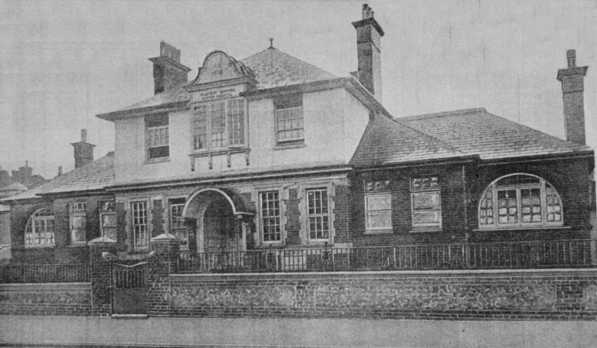
In 1899 a pair of semi detached cottages were adapted for use as the first Sutton Hospital. Almost immediately it was seen that this was to be insufficient to meet the needs of the area and Passmore Edwards was approached. He agreed to build a hospital on land to be provided by the community. Mr R C Foster, a local JP and later Sir
Ralph Foster, provided a site in Hill Road and Cecil Sharp was commissioned to design the new hospital with a central block for Matron and the nurses and the two 4 bed and two 2 bed wards, together with an operating theatre, being either side. . Passmore Edwards laid the foundation stone on 1 May 1901 and the hospital opened the following year. It cost £2800.
Even this accommodation was soon too small and an extension was added to bring the number of beds up to 20.
As the population grew the need for additional facilities increased and in 1927 a new site, on which the current hospital stands was purchased. The new hospital was opened in September 1931 by Sir Alan Garrett Anderson, the son of the pioneering woman doctor.
The Passmore Edwards building was demolished at some unknown date and premises known as The Adlers erected on the site. This has since been acquired by J D Weatherspoons Ltd and is now known as the Moon on the Hill.
The Schoolmaster, The Journal of the National Union of Teacher, 30 September 1899
The Schoolmaster: 30 September 1899.
All roads led to Sydenham on Saturday. From welsh mountain and Devonshire valley, from Yorkshire moor and Northumbrian borderland came the happy pilgrims to take part in the rejoicings at the completion and opening of the Passmore Edwards House for the orphans of teachers, to congratulate the London brethren on the magnificent work they have accomplished through the Special Effort Fund, and to thank Mr Passmore Edwards and Mr Whittick Rabbits for their splendid munificence. It was indeed a day of triumph, and the faces of the great gathering showed more than the mere applause how much the day meant to the profession. Outside the Conference themselves it would task the memory of our eldest members to recall such a representative and influential massing of the forces of the Union, With nearly
Twelve Hundred Present,
Most of whom are known throughout the kingdom, it would be easier top say who were not present than to mention those that were. London was naturally well represented. West ham sent a worthy contingent of well-known workers, and the other extra-metropolitan associations showed their sympathy by the presence of many of their local leaders.
Although the opening ceremony was fixed for three o’clock, the House was well filled before two, and the early arrivals took the opportunity of going the rounds before the crowd made circulation difficult. Westwood House, or Passmore Edwards House, as it will henceforth be called, was it may well be remembered, built from the designs of the late J. L. Pearson, R.A. some twenty years since, by Mr A. Littleton, of the firm of Novello & Co, as a palace for the entertainment of his musical friends. Five acres of beautiful grounds, gardens, paddocks, and lawns surround the House, which is reached by a magnificent avenue a hundred yards long. The great feature of the house is the magnificent music salon fitted in richly carved woods with a minstrel’s gallery at one end. It is said that the fireplace alone cost £1,000, and no expense has been spared to make the mansion a residence worthy of the kings of art. The doors are of elaborately carved mahogany, and the principle staircase is ornamented by sculptured figures on the newels. The winter gardens have domed roofs, and the garden terraces are amongst the happiest features of the design. Since coming into the hands of the Orphanage Council, a few alterations have been made to suit the new arrangements; but the thoughtful care of the members has allowed of this being done without interfering with the harmony of the
Beautiful Work of Art
which the House really is. The coach houses have been utilised as workshops and gymnasium, and the necessary sanitary arrangements have been made without breaking in any way the line of the building.
A tablet bearing the words:-The Passmore Edwards House for the Orphans of Teachers,” has been placed over the north front, and a brass plate with the following inscription is to be put up in the hall:-
PASSMORE EDWARDS HOUSE FOR THE ORPHANS OF TEACHERS,
To the Glory of God, and the Succour of the Fatherless, this House is dedicated,
This House and Grounds were opened as a Teachers Orphanage on September 23rd 1899,
By
J Passmore Edwards, Esq.,
With his noble benefaction and the proceeds of a Special Effort made by the Metropolitan Branches of the National Union of Teachers.
The Council of Teacher’s Benevolent and Orphan Funds were enabled to purchase the Freehold from the generous vendor,
C J Whittick Rabbits, Esq., JP.
OFFICERS:
Of the Council” Of the Special Effort:
Mr James Hodge, Chairman Mrs E M Burgwin, Chairman
Mr Fred W Hearn, Treasurer Earl Jersy, Jnt Teasurer
Mr J H Yoxall, Secretary Mr S Creswell, Jnt Treasurer
Mr W W F Osborne, Secretary
On Saturday the arrangements were in the hands of a special committee, and Mr Hardy with a band of devoted stewards made things easy and pleasant for the visitors. Indoors Mrs Burgwin, the “mother of the orphans,” received her guests, noble and simple, with the charming tact, which has so often, stood the Union’s Charities in good stead. Miss Ansell and Miss carter were in the forefront in showing visitors round, and we trust that few teachers will pass through the metropolis without sparing a few hours to view their latest acquisition. The dormitories are beautifully light, with an outlook that it would be hard to better, and the genial surroundings do much to take away the sad thoughts which those little beds, with their pathetic associations, call up. The day room is bright and cheerful, and it is to be hoped that before long the walls will be hung with pictures worthy of the building. Here is a chance for the many art lovers amongst our readers; for although the splendid decorations of the House prevent any suggestion of coldness, it cannot be doubted that the addition of some good pictures would help to cheer up our little guests who have now taken up their abode there.
With military punctuality the band of HM Scots Guards, under the baton of Mr Henry T Dunberton, opened the proceedings with a cheerful marching tune, and the platform erected at the South Front was speedily filled with the invited quests. Amongst them were:-
Sir George Kekeich, Mr Passmore Edwards, Mrs Passmore Edwards, and Mr Harry Passmore Edwards, Sir Charles Elliott, and Lady Jersey; Mr C Bowden, the Rev F Storer Clark, Mr T Gautrey, Mr A J Mundella, Mr J Sinclair, and Mr Warmington, members of the London School Board; Dr Garnett, Secretary of the Technical Education Board of the London County Council; Dr Heller; Mr T Clancy, President of the N.U.T.; Mr Marshall Jackman, Vice President , and Miss Jackman; Mr C James, Assistant Secretary, and Mrs James; Mr A Golding, Secretary of the Funds; Mr A A Thomas, BA, Secretary of the Examinations Board; Mr C J Whittick Rabbits, the generous vendor of the House, and Miss Rabbits; Mr J Hodge, Chairman of the Council, and Mrs Hodge; Mr P Baxendale, Vice Chairman of the Council, and Mrs Baxendale; Mr F W Hearn, Treasurer of the Funds, ( and many more listed by name).
A number of telegrams from those unable to attend were also read out)
THE OPENING CEREMONY
The skies look rather threatening as the company rises to sing the opening hymn-“O God our help in Ages past”- but the rain considerably holds off for the first part of the ceremony. Mrs Burgwin is in the chair, looking radiant at the success of her effort. She is supported by the Vicar of Sydenham, Mr James Hodge, lady Jersey, Sir George Kekewich, Mr Clancy, Mr Baxendale, and other well known friends.
The hymn is sung with marvellous effect, the orphans at the foot of the platform taking no small part, and then the vicar of Sydenham offers up a short prayer for the present and future dwellers in the home. The Lords Prayer follows, and the chairman arises amid loud applause to give a short history of the movement. She points out the difficulties that had to be contended with in obtaining a suitable site. Time after time the sites Committee had been disappointed; but at length, through the generosity of Mr Passmore Edwards and their good friend Mr Rabbits, they had succeeded. They all knew now how Mr Richard Greenwood announced that Mr Passmore Edwards was prepared to give £6000 for the building if a site could be obtained, and how Mr Rabbits had generously let them have the beautiful building and grounds for the low price of £10,000. The London teachers had done splendidly, and she believed they would not rest until the full £10,000 was obtained. Continuing, Mrs Burgwin called forth hearty cheers by saying that there should be two portraits hanging in the hall. One of Passmore Edwards and one of Mr Rabbits. The names of these two gentlemen would, she said be handed down as happy memorials of unselfish kindness to the children to whom that house would be a source of refinement and progress, and the portraits wou’d serve as a reminder of their discerning liberality.
The House Beautiful
Would lend dignity to the whole body of teachers, and confer exceeding pleasure in possession. It would stimulate the imagination of the boys and be a source of inspiration to them in future life. “Who,” she asked, “could live here without having manners mellowed and every rude and brutal passion softened? No boy will be ashamed to own that he was brought up and educated in this house, but each one will look back with glowing pride and heartfelt joy at this place and its advantages. Moreover, these surroundings will stimulate the teachers and boys to take up literary and humane studies, and thus counteract that scientific materialism which Mr Bryce has so eloquently denounced. Not from this place can go forth the hard, dry, gritty and infertile mind. Here poetry, painting, music, architecture, and that Christian religion which has kindled these arts into a fierce flame in the bosoms of their possessors are everywhere present, teaching the lessons of enthusiasm, stirring the soul to valiant deeds, to brave danger and pain, and to go to labours cheerfully until life’s end”. An enthusiastic burst of cheering breaks in upon this eloquent expression of hope. When it subsides Mrs Burgwin goes on to show the advantages of the situation-sufficiently in the country to enable the boys to watch the progress of the trees and flowers from season to season, and near enough to the greatest city in the world to keep them in touch with the art and science of the world. Near to was the magnificent foundation of the College of God’s gift, the Dulwich gallery, the Horniman Museum and the Crystal palace. She was convinced that the presence of the orphanage in the midst of so many wealthy and splendid mansions would be no detriment to the neighbourhood, but on the contrary, would be welcomed with that
Cordiality, Benevolence and Hospitality
so essential to social communities. “This house” she continues will, we believe, inspire prayer, counsel, forgiveness, stifle self, and be a seminary of progress, sending forth heroes, inventors, men of practical science, student, and teachers of the highest patriotism and godly fear. And so thinking, fellow teachers I am joyful, and in our joy and in our gratitude we echo the words opf St Peter with all reverence, “Master, it is good for us to be here”. The vast audience were held spell bound by the speaker’s splendid peroration, and the cheering was long and general as she turned, with a few words, to present the key of the house to Mr Passmore Edwards as a memorial of the occasion. “Take this key as a memorial of this day. You will see that it is engraved with the motto of your life- Charity. Old and young in the years to come will rise up and call you blessed”.
Mr Passmore Edwards, who was received with three hearty cheers, said that it gave him the greatest possible pleasure to be present, but as he had to speak later on he would only at this stage express his thanks for their kindness. Renewed cheering burst forth and then three cheers more. When silence returns, Madame Antoinette Sterling rises to sing “O Rest in the Lord” with a feeling and emphasis that lend additional effect to the magnificent voice of the singer.
Mr James Hodge (Chairman of the Council) now steps forward to receive the keys of the house. In a few telling sentences Mrs Burgwin charges him to guard it “for ever”, as the trustee of the teachers of the country.
Mr Hodge, who was loudly cheered, said that, although he could not guard it “for ever” as the Chairman suggests, he would do his best to guard the funds of the home as long as he was able and then hand over the work to those who came after him. This was not the place, and he was not the person, to make a long speech, but it was his duty to move a vote of thanks- in no formal manner- to the gentleman whom they thanked not only for his munificent gift, but for the unvarying kindness he had shown to them, Mr Passmore Edwards. After the cheering which invariably broke out at the mention of the name of the generous donor had subsided, Mr Hodge went on to detail the trials and struggles of the house Committee. If it had not been for Mr Passmore Edwards, he said, the orphans would still be at Peckham. Mr Edwards’ splendid benefactions has made his name
A Household Word throughout the Country.
His work in connection with the Free Library movement appealed to them all as teachers, for public libraries were most valuable adjuncts to the schools. They all agreed with John Morley in his estimate of the advantages to be derived from living with good books, and he was glad of the opportunity of thanking Mr Passmore Edwards in the name of the teachers for his splendid gifts throughout the country. But Mr Passmore Edwards was an inexhaustible topic, and he would now move, in the hope that that day would long be a happy memory, the following resolution:-
“That this meeting, on behalf of the Teachers Benevolent and Orphanage Fund, recognising its great indebtedness to Mr Passmore Edwards, hereby tenders him its heartfelt thanks and unbounded gratitude for his disinterested and generous support of the Union’s charitable Funds; and further, it desires to express the fervent hope that he may long be spared to see the fruit of his noble work not only in this, but in the many institutions associated with his name.”
The cheering was again general as Mr Richard Greenwood, who looks as if his hard work in the cause had done him actual good, rose to second the resolution, which every teacher in the land supports. He could not, he said, find words to express his feelings and the feelings of them all; but he did thank God that he had put into the heart of a man to devote his life to doing good to his fellow creatures. It would be impossible to give a list of the good works of Mr Passmore Edwards, but he would tell them a story. This was, of course, a signal for a general smile, for who has not enjoyed Mr Greenwood’s little stories? There was, he said, a company formed in Cornwall for the purpose of building a series of large hotels for the convenience of Londoners and others, but he heard that they were unable to go on because
All the Best Sites had been Bought Up
By Mr Passmore Edwards as sites for hospitals and public libraries. Mr Edwards evidently enjoys this little joke, and Mr Greenwood is careful to explain that he does not warrant the story beyond the usual warrant of his little tales. Continuing in a graver vein, the veteran eulogises Mr Edwards for the personal care he gives in making his benefactions. When he first went to Mr Edwards he had to give assurances that the teachers were in earnest in the matter, and then he decided to help them liberally. He trusted that he would long be spared to see some of the fruits of his work; but even if he had no reward in this world he would in the world to come. More cheers as Mr J H Devonshire whose name has long been associated with the Orphanages, reminds us of the preface to this great work which he said was read at Liverpool in 1875. He was glad to see this, the closing of the first chapter, and still more delighted to see Dr Heller, his old co-worker, present to enjoy it all as well. Mr Passmore Edwards would have in that house living monuments more enduring than any structures of stone or iron. A storm of cheering announces the fact that Sir George Kekewick is on his feet, and the “new model” Education Secretary has to wait some time before he can begin. Sir George is in fine form, and delivers one of the best of the many happy little speeches with which he has cheered the meetings of the Union during the last few years. He is there, he says, not because he is the Secretary of two education Departments- it takes the meeting some seconds to see this sally, but one orb two see the point and the roar becomes general-nor because he is an orphan, but because he has always taken the keenest interest in the orphanages of the NUT, and because he was grateful to Mr Passmore Edwards for his munificence. In his opinion
A Donation to the NUT was a Donation to the cause of Education
And he is additionally grateful to Mr Passmore Edwards because the Orphanage and Benevolent Fund serve to strengthen the bonds of the NUT, They were branches that all could support, and anything that binds the NUT more strongly together is good for the cause of education. He looked upon the NUT as a bulwark against reaction in education, and a guarantee of the freedom of the teacher. The words of the Secretary of Department were punctuated with hearty applause, and Sir George sat down amid a ringing round of cheers.
Mr Passmore Edwards, who was greeted with cheers and musical honours, rose to reply, but the rain began to fall, and his speech was unfortunately curtailed. He said that that day would be a red letter day in his life. He had every reason to believe, from personal knowledge, that anticipations of the future good work of the Orphanage would be realised, Their commencement, like that of most other institutions of a similar nature , was almost microscopic in character. The income for the first year was £78, and the expenditure £37 11s 1d. Very substantial progress was, however, almost immediately made, in so much as 1879 £1654 was credited to the Orphan Fund, and £524 to the Benevolent Fund-total £2178. But so nobly have the teachers of the country risen to the needs of the widow, the orphan, and their suffering comrades, that for 1898 the total income raised was no less than £9507 13s 7d, and this , indeed, was not so much as some previous years have produced. Since 1878 the total sum raised for these charities is £131,900. Of this sum £35,564 have been invested, £18321 has been paid in home allowances, £23,817 expended on the two orphanages, £1918 in special grants, £11709 in temporary relief, £5038 on loans, £12854 on annuities. He was exceedingly grateful to them for their vote of thanks, and if in the future he could render them any assistance, he should be happy to do so. Loud and continued cheering followed the speech of the founder, who has evidently won the hearts of all by his generosity and goodwill.
Thanks to the Special Effort Committee.
Mr T Clancy, MA, President of the National Union of Teachers, moved the vote of thanks to the committee under difficulties, for the rain continued, but in the name of the teachers of the country he thanked the London teachers for the splendid effort which had been the means of raising £7,300, and he trusted that the good example of London would have a good effect in the country. Only 3% of convicted criminals were persons of education, and he thanked God that their own little children would be saved from the possibility of ignorance and crime. The London teachers had strengthened the bonds of friendship and the feelings of humanity, and the children would thank them in the years to come. The grateful feelings of all the teachers in the country were turned to London, and as President of the union and as a father he thanked them from the bottom of his heart. They would themselves be the greatest gainers , for every noble work done ennobles the one who does it. He wished them God-speed, and moved the vote of thanks with the greatest cordiality and gratitude. The cheering is again general as Mr Baxdale (Vice Chairman of the Council) seconds, and Mr Bird (Vice Chairman of the House Committee) supports in the shortest speech on record. The Countess of Jersey was unfortunately unable to remain to reply but Mr Cresswell (treasurer of the Special Effort Committee) does that duty efficiently and declares that the London teachers, having put their hands to the plough, would not look back until the whole £10,000 was raised. Mr Langler lifts up his umbrella and shouts “we Will” with an energy that leaves no doubt in our minds. Mr Baxendale would have liked to have mention some of the workers, but time permits him only to name Mrs Burgwin, the mother of the orphans, whose name would never be forgotten, and Mr James Hodge, who had worked so indefatigably in the cause. The Special Effort was an absolute necessity, he tells us for the teachers were giving all they could in annual subscriptions, and there was no margin for the new building, but the London teachers had pout there backs into the matter, and the result was before them. The rain clouds have by this time passed away, and the gathering is put in good humour by a welcome announcement of
Mr Treasurer Hearn,
Who comes forward to tell us that mr Bailey, of the well known Educational Musical Instrument Co. had just promised to present a splendid upright iron grand piano of the value of seventy five guineas to the orphanage. We cheer and cheer again, and Mr Hearn’s evident happiness is reflected on all our faces.
Thanks to the Chair.
Mr J Whitlock Rabbitts, JP, to whom next to Mr Passmore Edwards we are indebted for the orphanage, moves the thanks of the meeting to the chairman, and in doing so advises the members when they have anything particularly difficult to carry out, to apply to Mrs Burgwin. Laughter and cheers follow, and Miss I Cleghorn, LLA (Chairman of the Sheffield House Committee) seconds. She happily styles the meeting a harvest festival of human effort. The country teachers would never forget all the good work done by Mrs Burgwin, and on behalf of the 40,000 she cordially thanked her.
Mr Passmore Edwards, who was again enthusiastically cheered as he rose to put the motion, reads a letter he has received from a resident in the neighbourhood who objected to the orphans being housed in the district and carries the meeting with him as he reads the reply sent. This ran as follows:-
“My Dear Sir,- You should address yourself to the Teachers’ Benevolent Society, and not to me, in reference to the Teachers’ Orphanage; but I believe it is too late to alter the decision come to, and particularly for the miserable reasons mentioned in your letter. Westwood House has not been inhabited for years, and you would prefer its remaining so rather than it should be inhabited and enjoyed by poor orphans who probably are as much deserving the favours of Providence as you are. You evidently object to there near neighbourhood because they are poor and if so it reflects no credit to your head or your heart. You will probably now have an opportunity to learn that teacher’s orphans though poor, are clean, well behaved, and respectable- Yours faithfully, J. Passmore Edwards”
The resolution of thanks is now put and carried by acclamation, and then Mrs Burgwin and Mr Hodge having briefly replied, the ceremony closes with the Doxology.
Time is provided for refreshment, and the Scots Guards delight the company with a programme of fine music.
A grand concert, arranged by Mr Ben Johnson, was then given in the beautiful music room, which with the conservatory adjoining were packed with an appreciative audience. Miss Fanny Woolf’s violin solos won great applause, the extreme brilliancy of their execution being enhanced by the charm and grace of the player. Madame Olive and Messers. Ben Johnson and Mr Mullerhausen contributed vocal items, and Mrs Ben Johnson and Mr Manaton were admirable accompanists. Madame Antoinette Sterling won all hearts by her declaration that she “just loved them all, every man and woman in the room, because they were teachers, the calling she thought the most noble in the world”. She said she had not brought any music, so must sing without accompaniment. She gave “De Master ob de Sheep”, a haunting minor negro melody, and a little song the words of which were written by her daughter when a little child. Then she sang” There’s nae luck aboot the hoose”, and in reply to repeated requests for “Darby & Joan”, good naturedly acceded to the desire of the audience. In the two latter she was accompanied by Mr Manaton.
As the audience files out a scene of fairy beauty is before them, for the trees have been outlined with coloured lights. In the Dell a marquee has been erected, and is used as
A café Chantant
Where the ubiquitous Mr Fred Hearn, Miss Katie Malone, Mr Newman Stratton, Mr J H Mullerhausen, Professor Banbridge, Mr Harry Hawkes, Mr Henry M Grey, and Mr Habbijam’s Amphion Glee men have crammed and delighted audience until the chimes over the house buildings warn us that the day is over, and, with heartfelt thanks to the donors and the Committee who have managed all so well, the first garden party of the Passmore Edwards House comes to an end.
Whitechapel Library 1892
The first of the Passmore Edwards Libraries to be built in London, and the first rate supported library in the East End, was the Whitechapel Library.
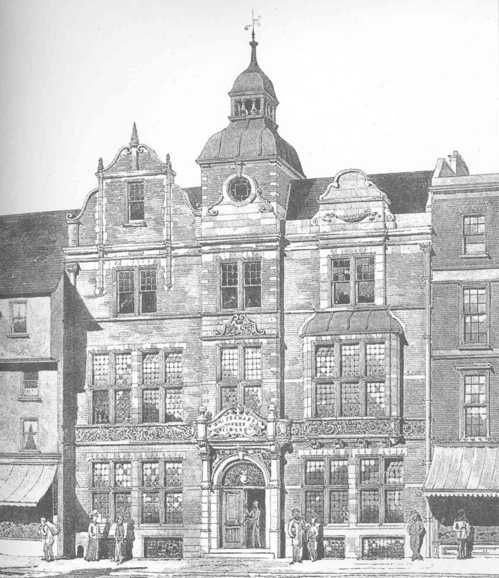
History
Canon Samuel Barnett, and his wife Henrietta, had moved to St Judes’ Parish, Whitechapel in the 1870s, an area of appalling poverty, poor housing conditions and overcrowding; mostly involving Jewish immigrants from Eastern Europe. The Barnett’s set about improve the conditions of their parishioners. Barnett campaigned for adoption of the Free Libraries Acts and a poll in 1889 voted by nearly 4 to 1 in favour. At the first meeting of the Library Commissioners, in January 1890, Barnett reported that he had collected promises of £4,500 towards the library and a suitable site was obtained on the High Street; the busiest part of Whitechapel., The foundation stone was laid by the Lord Mayor in July 1891.
When the vicar of St Paul’s, Dock St, offered his entire collection of relics, fossils and works of art, some very rare and valuable, as a nucleus of a museum, ‘if proper accommodation could be provided’, the architects were asked to amend the design. The building was almost complete when Canon Barnett invited Passmore Edwards to view it, hoping to obtain a donation that would close the shortfall on the required funds. Edwards was sufficiently impressed to later write ‘I cheerfully comply with your request and relieve you of the difficulty which presses upon you by paying the entire cost of the building … . I do this not merely from a sense of duty, but because I think it is a distinguishing privilege to assist in lightening and brightening the lot of our East End fellow citizens’. Included was a cheque for £6,454 to which he added the offer of a thousand books.
The library, designed by Edward and William Potts, and Arthur Hennings, set the pattern for East End libraries, which, though by different architects, are similar in their domestic scale and the general seventeenth century asymmetry.
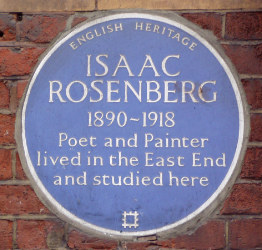
By May 1892 the Reading Room was open and the official opening of the library, by Lord Rosebury, took place in October. In the week prior to the opening more that 2,500 were using the reading room daily with another 1,264 on the Sunday. Hundreds of other books were to be donated, even before the library opened, including a copy of the Koran. During the first year more than 2,500 residents registered as members and for many the Whitechapel library, soon to be known as the ‘University in the Ghetto’- promoted by its librarian, Morley Dainow, was the only means of getting an education. Members in those early years included First World War poet Issac Rosenburg who perished on the Somme, Jacob Epstein, the sculptor responsible for the work representing St Michael at Coventry Cathedral, and historian Jacob Bronowski, creator of the TV series, the Ascent of Man. Playwright Bernard Kops wrote about the Whitechapel library – ‘the door of the library was the door into me’.
From the beginning Hebrew books and papers were provided, the library later holding the largest collection of Jewish books in any UK public library. By 1910 a Hebrew assistant, Mr Bogdin, was appointed to manage the collection of books in Hebrew, Yiddish and Russian, a collection that remained in the library for 70 years. Loans peaked in 1937 at 18,000 volumes but in 1970 Indian language books were added to the catalogue for the first time and soon outnumbered Hebrew and Yiddish issues.
Always at the forefront, as the immigrant population changed so did the library’s membership and the library was the first to stock Somali texts.
The Whitechapel library, like several in London, was damaged during the air raids of World War Two, the upper floor being completely burnt out and not reopened until 1955. It also stands not far from the site of the Brick Lane restaurant bombing, of 1999, and the Tube bombers target at Aldgate in 2005. Though escaping these threats to its existence the building could not escape the march of progress and closed its doors in August 2005, the library moving to a new building in front of Sainsbury’s – The Idea Store.The opportunity was taken to restore the building and create an extension of the adjacent art gallery.
Potts & Hennings
Edward Potts (1839-1901) was born in Bury, Greater Manchester on 4 March 1839. He was articled to George Woodhouse from 1854 and in the London office of John Pritchard and John Pollard Sleddon from 1860. In 1861 Potts went into partnership with G Woodhouse in Oldham and was later Senior partner in Potts, Sulman and Hennings of London
Arthur William Hennings (1872-1926) was born in Manchester. Articled to Sir John Sulman in May 1872 he remained in that office until February 1888 He passed his qualifying exam in 1888.
Hennings continued the business of Sulman when he left for Sydney, in partnership with Edward Potts and Edward’s son William Potts.
William Edward Potts was a pupil of his father from about 1875 and remained in the office of his father excepting for 18 months in the office of John Sulman. Studying at University College, London he passed his qualifying exam in 1888.
Extracted from Directory of British Architects 1834-1914, British Architectural Library.
St Mary’s Church Gardens, Woolwich 1895
Passmore Edwards’ first contribution to the work of the Metropolitan Public Gardens Association was to fund the transformation of the overgrown grave yard at St Mary’s Church, Woolwich.
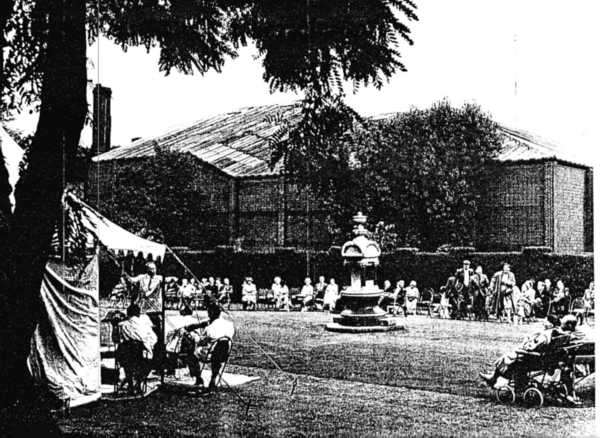
History
In 1892, the Chairman, of the Metropolitan Public Garden Association, Lord Meath wrote to Passmore Edwards asking for assistance in the work of the association. His reply was:-
” My Lord
In answer to your letter asking me to subscribe towards expenses in utilising for public purposes the large parish churchyard of Woolwich, I cheerfully comply with your request. The very last thing I would sanction would be the desecration of “God’s Acre”. A graveyard, to my mind, is holy ground, and I never knowingly pass one without raising my hat. But for the sake of the living, and particularly in this overcrowded metropolis, where millions of our fellow citizens pass mostly, comfortless lives, I would make churchyards sweet resting places for the weary, and picturesque recreation grounds for the young.
You say that Woolwich churchyard is about four acres in extent and that it is near the centre of the town and situated on high ground, that it overlooks a fine view of the river Thames, that it would make a delightful garden, and that it the estimated cost of preparing it for public use would be about £1200. The object aimed at is so good, and the derivable benefit so certain, that I most willingly respond to your appeal and undertake to meet the whole of the estimated charge. Please accept this as my New Year’s gift to Woolwich, and believe me, –
Yours faithfully
J Passmore Edwards.”
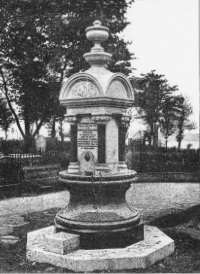
By the opening in May 1895 St Mary’s graveyard, which had long been a wilderness, put on a new garb and bloomed with Flowers. The garden was opened by the Duchess of Fife, accompanied by the Duke. Lord Meath said that previous attempts to put the graveyard in good order had been made for over 10 years. It was only, with the generous aid of Passmore Edwards that is had been possible. 5 years later Passmore Edwards added a drinking fountain and provided funds to keep the garden in good order.
Although laid out by the MPGA the garden remained under the control of and maintained by the local authority.
The gardens have been extended and maintained by the local authority since 1895. On 1 April 1965 Woolwich became part of the London Borough of Greenwich and the maintenance of the gardens continues under their management to this day. In 1968 the remaining memorials were removed leaving only the Tom Cribb Memorial. It was probably at this time that the fountain, erected at the expense of Passmore Edwards, was also removed but I have been unable to determine its fate.
The present retaining walls and slopes between the gardens and Woolwich High Street were built in 1966 as a part of the construction of the new terminal for the Woolwich Ferry. At this time a plague pit was found and gardeners found several lead coffins whilst landscaping the banks.
Until the 1980s there was a glasshouse in the staff yard for growing the bedding plants. There was also a plot of land, now a lawn, where shrubs and other plants were grown.
